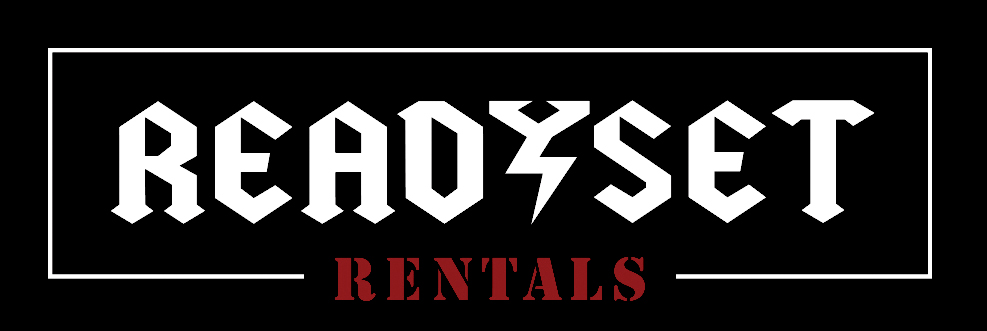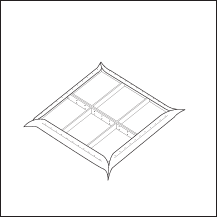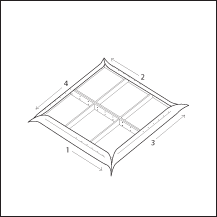Category: HowTo
Paint A Wall
Required Tools: drop cloth, extension pole, roller with sleeve (1x per color), brush (1x per color), tray (1x per color)
Recommended Tips:
- Keep a damp rag in your pocket to quickly wipe up your mistakes.
- All paint finishes, with the exception of flat finish, should be applied in one direction. Meaning if you begin at the top of the wall, working your way down, you should continue painting top to bottom across the entire wall.
- When allowing paint to dry, or taking a break, be sure to cover your paint tray, roller, and brushes so they do not dry out
Step 1 .
When using flats that have been seamed together and stretched with muslin, be sure that the surface of the muslin is free of wrinkles and other debris. Please note, the paint will tighten the muslin, but will not remove large wrinkles or sags. When using flats that have been seamed together and have spackled seams, be sure the spackle has been sanded and the surface of the wall is uniform and smooth. Please note, paint will not hide problem areas. For both types of walls, use blocks to lift flats off the ground and slide a drop cloth under the front edge of the flats to protect the floor from paint.
Step 2 .
If there are windows or moldings, you will need to “cut in” first. Using a paintbrush, run a line of paint along the wall about an inch away from the edge. Then turn the brush onto the bristle tips, and press down slightly so the longest bristles gather into a point. Use this point to apply a careful line of paint right up to the edge where wall meets the molding. Once you have a clean line in place, level out any heavy areas or drips, and then move on. Once you’ve cut in around an entire wall area, you will use a roller to fill in the field.
Step 3 .
Fill the well of a roller pan about half full, and set the roller into the middle of the well. Roll it back and forth against the slope of the pan 2-3 times to allow the paint to work into the roller sleeve. Dip the roller into the well once more, and roll it on the slope until the sleeve is well saturated, but not dripping. You’ll know immediately when you’ve overloaded the roller, as it smears instead of roll across the surface of the flats. Be careful not to run the roller so rapidly across the flats the centrifugal force causes the paint to spray.
Step 4 .
Beginning at one end of the flats, about chest high, evenly apply a vertical stripe, slightly overlapping your cut-in edges (DO NOT apply the paint in a zigzag pattern making ‘M’ or ‘W’ strokes…it will look wack). Reload the roller with paint, and continue moving across the flats, overlapping your previous strokes to spread and blend paint evenly. It is ideal to point the arm of the roller handle in the direction you are moving across the wall.
Step 5 .
To ensure uniform coverage, a second coat will be necessary, but wait until the first coat is dry to the touch, then repeat steps 2 and 3. Please note, very saturated colors may require a third coat.
Backdrops
Backdrops are made with latex paint over fabric – they are subject to damage from water, nails, staples and other things commonly found in studios. Whenever a backdrop is to be unrolled or re-rolled using the floor, make sure the floor is swept and free from all dirt, dust, staples, screws or other items that might cause damage. A backdrop is also ruined when folded, that is why they are delivered rolled tightly onto cardboard tubes (aka “cores.”) They must be handled gently, with a minimum of two people, and must be returned in the condition they left our shop. Damage fees will apply and may amount to the cost of replacing with a new backdrop. Please follow the guidelines below and call with any questions if a ‘situation’ arises.
HANGING
Backdrops can be hung from a crossbar or affixed to a flat, smooth wall. A minimum of two people is required to hang a backdrop. When using a cross bar make sure the hi-boys or stands are set at a distance slightly wider than the backdrop. Affix the backdrop to a metal bar with c-clamps or tape. Secure the backdrop to wooden crossbars or walls with c-clamps, tape or staples. Clamps and staples should be set 12” apart. Please use only a two-inch margin around the edge of the drop for securing. Damage fees will apply if the image is damaged.
When unrolling a backdrop horizontally one person unrolls the canvas while the other person secures it at the top. When you’re unrolling a backdrop vertically set the hi-boys to desired width and unroll the canvas on the floor once it’s been swept clean. Then secure the top of the backdrop to the crossbar and have two people raise it to the desired height. Any excess length at the bottom should remain rolled on the core tucked under and behind the set. NEVER fold or have anything with weight pressing down on top of a roll. Damage fees will apply. DO NOT DISCARD the cardboard tube/core as you will need that to return the drop.
RETURNING
To reroll a backdrop there are two options, a minimum of two people is required for each.
Option 1 – If the backdrop is set on hi-boys you may lower the drop to a clean floor to re-roll onto the supplied tube/core (which you stored behind the set, right?) Do not allow the drop to fall or crumple. Be sure to sweep the floor you will be laying the backdrop on. Place the drop face up on a clean floor and return onto the core by rolling from the bottom, being sure it is tightly rolled and square (no telescoping, PLEASE!). Also clean off any accumulated dust or other particles from the face of the drop. Do not place tape on the face of the backdrop. Secure the top of the drop with tape at the ends and in the middle.
Option 2 – If the backdrop was secured to a flat wall one person will remove the tape, staples…that are securing the canvas to the wall while the other person places the cardboard tube/core at the end and begins to re-roll the backdrop tightly to the tube. This process continues until the canvas is completely rerolled and then it is secure with tape at the ends. No tape is to be placed on the front of the image.
STEP 4
Finish stapling all sides, stopping a few inches short of the corners.
STEP 3
Continue to pull fabric taut and staple to the ribs working outward from the centers on opposing sides.
STEP 2
Pull the fabric taut beneath the wall. Stretch the fabric up and around the flats at the center of each side and staple into the back edge of the plywood ribs.
STEP 1
Spread the fabric onto a cleaned area of floor. Remove jacks from the wall and lower it face down on top of the fabric.
STEP 5
To reinforce the seam, “double-up” the screws at each location on the side of the rib away from the face.
STEP 4
While adjusting the flats to keep their faces flush, move up the seam inserting a screw approximately every 1′ on the edge of the rib nearest the face.
STEP 3
Insert a 1-5/8″ screw through the ribs of both flats at the bottom inside corner.







